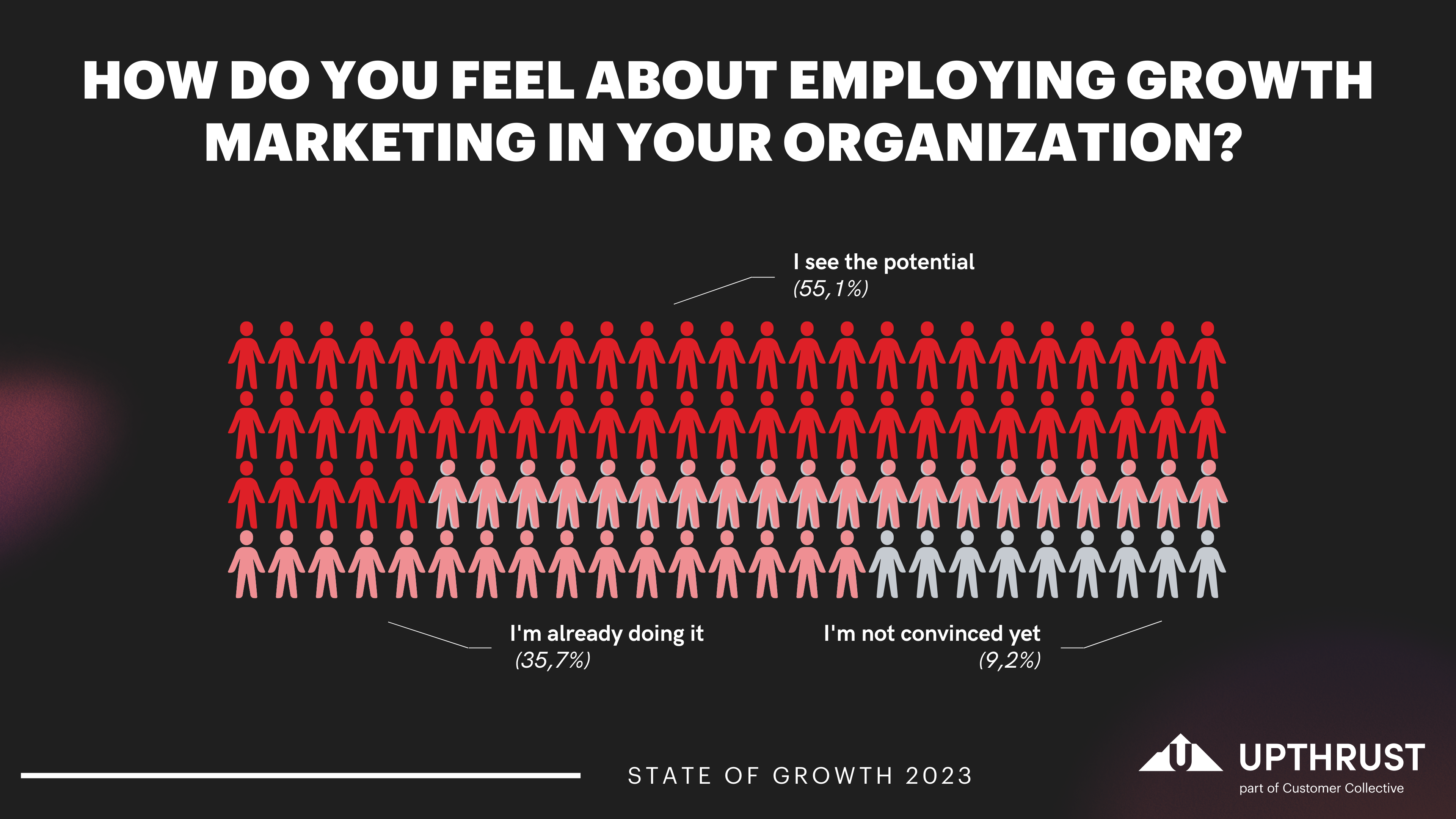A Look at Growth Marketing Today: State of Growth 2023

Get your copy of the State of Growth 2023!
Growth marketing is the process of creating a strategy and executing tactics to achieve your company’s goals. It is about getting more customers, increasing revenue, building brand awareness and improving customer retention.
In the State of Growth 2023 survey we asked Belgian marketing leaders what they do in their day-to-day jobs as well as how they define growth marketing and how they practice it in their business.
About the State of Growth 2023
The State of Growth 2023 survey brought together over 350 Belgian marketing leaders who were eager to share their growth strategies and performance of Belgian Growth Teams.
We challenged our participants to rate their familiarity with growth marketing on a scale of 1 to 5, with 1 being “I don’t know what growth marketing is” and 5 being “I’m an expert.” The average score came out to 2.5, which means there’s room for improvement and growth!
We also asked the participants whether they believed growth marketing could help their business or not.
The results?
Only 35,7% say they’re already using growth marketing to boost their business.

The World is Constantly Changing
The world is constantly changing, and so are the marketing strategies that companies use to stay ahead of the curve. As a result, the traditional method of marketing–which relies on one-way communication and mass media–is becoming less effective than ever before.
Innovation is at its peak in today’s world, thanks to advancements in technology and social media platforms like Facebook and Twitter. The growth of these platforms has led to an increase in user engagement levels across industries; however, marketers still face challenges when trying to reach their target audiences effectively without spending too much money on advertising campaigns (or not enough).
So what does this mean for your business?
Experimentation vs Growth Marketing vs Growth Hacking
One of the most significant eye-openers presented in the State of Growth report is the confusion between growth marketing and growth hacking.
While growth hacking focuses on the tactics and ideas to spread and launch experiments, growth marketing involves managing the process within the organization to have more agile, lean, and data-driven marketing.
Growth marketing is not just about launching experiments, but it involves an organized approach that puts different functions together to ensure that the marketing strategies are data-driven, lean, and agile.
However, experimentation is a critical component of growth marketing, which involves testing different strategies and tactics to identify the most effective ways to grow a business. In growth marketing, experimentation refers to the process of creating a hypothesis about a potential growth opportunity, designing an experiment to test that hypothesis, and measuring the results to determine whether the hypothesis was correct.
The Upthrust State of Growth 2023 reveals that over 20% don’t experiment at all, which means that there’s no base for optimizing their marketing strategy.
To start an experiment, a growth marketer would begin by developing a hypothesis about a specific area of their marketing strategy that could be optimized for better results. This could include anything from improving website user experience, increasing email open rates, or enhancing social media engagement. The hypothesis should be framed as a statement that can be tested and should be based on existing data, such as user behavior patterns or conversion rates.
Next, the growth marketer would design an experiment to test the hypothesis, which can take many forms depending on the area being tested.
After running the experiment, the growth marketer would analyze the results to determine whether the hypothesis was supported or not.
The growth marketer would then use the results of the experiment to optimize their marketing strategy further.
The power of data
Data in growth marketing is the most important thing, as it’s impossible to do growth marketing without measuring and keeping data.
The most successful growth marketers are data-driven and make decisions based on what they learn from their experiments. They use analytics tools to measure the impact of their campaigns, so they can optimize them over time.
Growth marketers track the return on investment (ROI) of each marketing channel, campaign, and tactic, in order to determine which ones are working best for them and which deserve more resources going forward. This helps ensure that you’re spending your budget wisely–and not wasting money on ineffective strategies or tactics that don’t produce results!
However, building the data infrastructure and dashboards can be a challenge. Some companies have long-term data roadmaps to go towards full end-to-end tracking dashboards, but these programs take time.
Therefore, companies are reflecting on setting up speedboat agile teams together with data specialists, marketing specialists, and creatives, to start learning, experimenting, watching, and getting value in an organized way.
The State of Growth reports finds that there is a significant gap between companies that were successful in growth marketing and those that were not. Successful companies had a more organized and structured approach to growth marketing, whereas unsuccessful companies had a more haphazard approach.
The report emphasizes the need for companies to invest in developing a structured approach to growth marketing.
One-size-fits-all?
Unfortunately, growth marketing is not a one-size-fits-all solution. Instead, it requires ongoing experimentation, analysis, and adaptation to stay ahead of the curve and outpace your competition. This means that growth marketers are not afraid to fail and learn from their mistakes.
By adopting a growth marketing strategy, businesses can achieve faster growth and increased revenue. However, it’s important to keep in mind that growth marketing is not a one-time solution, a quick fix or a one-size-fits-all solution. It requires ongoing experimentation, analysis, and adaptation to stay ahead of the curve and outpace your competition. This means that growth marketers are not afraid to fail and learn from their mistakes.
Conclusion
In conclusion, growth marketing is a process that involves managing growth within an organization. It requires an organized approach, including the proper data infrastructure and dashboards, to ensure that experiments are effective and that learnings are applied.
By focusing on measurable results, prioritizing experimentation, building sustainable growth, emphasizing customer-centricity, and taking a holistic approach, organizations can achieve faster growth and increased revenue.
And by setting up “speedboat agile teams”, companies can start learning from experimenting, watching, and getting value in an organized way. With the right approach, growth marketing can fuel marketing strategies for the year ahead.
So if you’re not yet implementing growth marketing in your organization, now is the time to start!
And great news: Upthrust is here to help you! Either if you’re looking to strengthen your growth marketing skills or if you need a team of experts in your marketing team, Upthrust is your go-to place.
